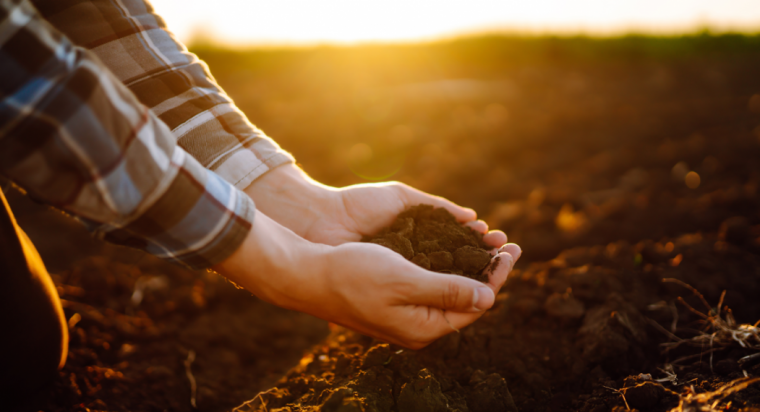
Today’s global agriculture and food systems are facing immense challenges. Mitigating and adapting to the impact of climate change adds to the complexity of growing food for our rising population. From breeding for less potent dairy cattle burps to promoting green ammonia in crop production, tackling climate change impacts from Canada’s agricultural sector is the goal of two national and international research projects being co-led by researchers at the University of Guelph’s Ontario Agricultural College (OAC).
How can crop production be more sustainable?
Reducing greenhouse gases from crop production is the goal of a new international research collaboration whose Canadian component is led by Dr. Claudia Wagner-Riddle [1], a professor in OAC’s School of Environmental Sciences.
The team is looking at alternatives to conventional fertilizer, whose ammonia base consists of hydrogen and nitrogen. While nitrogen is vital for promoting growth and crop yields, making ammonia requires fossil fuels and releases greenhouse gases, notably nitrous oxide emitted from soils due to nitrogen fertilizer application.
“The bottom line is that you can’t grow crops without nitrogen, so we have to really get a handle on how to use fertilizer in a way that minimizes environmental losses – and in the case of climate change, that means nitrous oxide emissions,” said Wagner-Riddle, an expert in measuring agricultural emissions of this greenhouse gas.
Referring to a federally mandated target for reducing nitrogen-related emissions by 30 per cent by 2030, she said, “That goal is feasible but there are a lot of questions. How will we monitor this and what will farmers have to do on specific farms?”
Answering those questions – including helping farmers shift to renewable and carbon-free resources without crimping crop yields – is the goal of the planned Global Nitrogen Innovation Center for Clean Energy and the Environment.
Based in Maryland, the new venture brings together researchers from Canada, the U.S., and the U.K. Within the global group, Wagner-Riddle will lead a team of researchers from four Canadian universities, all funded by $3.5 million from the Natural Sciences and Engineering Research Council through the National Science Foundation Global Centers Initiative.
The team plans to study what she calls the “3 Ms” – measurement, modelling and metrics – to provide ideas for farmers to understand and address farm emissions of nitrogen. Wagner-Riddle expects those ideas will yield technologies and practices for producers and other stakeholders along the food chain.
Such measures would complement conservation farming practices, notably cover crops and no- or low-till cultivation whose potential benefits include increased carbon sequestration.
Those practices are among initiatives being explored by OAC grad Aaron Stevanus, [2] a fourth-generation farmer whose 40-acre spread is located within a 30-minute drive of Guelph. Stevanus, Dip. ’03, B.Sc. (Agr.) ’07, and his wife, Anne McRae, B.Sc. (Agr.) ’05, grow mixed vegetables and cultivate row crops (corn, soy and winter wheat) in rotation.
Along with his winter wheat, Stevanus sows red clover as a cover crop to add organic matter, thwart soil erosion and help sequester carbon. He’s also using till and no-till practices to compare impacts on soil retention of water and nutrients.

Stevanus said these environmental stewardship practices are increasingly common among farmers eyeing both current yields and sustainability of cropland for future farming generations.
“Most farmers are attuned to what’s going on in their fields,” said Stevanus, who also practices permaculture and pollinator-friendly planting along his farm’s stretch of Ontario’s Grand River to promote biodiversity. “We’re keeping soils covered and trying to sequester as much carbon as possible.”
Can we breed cows that produce less methane?
In 2023, research led by animal biosciences professor Dr. Christine Baes [3] and colleagues resulted in the first national genetic evaluation in the world to enable breeders to select low-methane dairy cows.
Globally, burping livestock accounts for about 14 per cent of all human-derived greenhouse gas emissions [4]. In Canada, said Baes, agriculture is responsible for about 10 per cent of CO2 equivalents, including about 1.5 per cent coming from dairy cattle.
Reducing those emissions was the goal of her recent work, done in part at the Ontario Dairy Research Centre in Elora, Ont. Researchers refined technology for predicting methane emissions from individual cows by analyzing milk samples. Matching those samples with DNA from individual cows allows farmers to identify animals to breed for lower methane.
As part of genetic evaluations for Canadian livestock breeding, the tool will help breeders predict which cows will produce offspring that will ultimately belch out less greenhouse gas while continuing to yield as much or more milk.
“Canada is the first country to come out with a national genetic evaluation for methane emissions. This new evaluation will help us select the most environmentally efficient animals for breeding purposes," said Baes, who holds the Canada Research Chair in Livestock Genomics and is Chair of the Department of Animal Biosciences.
The project won U of G’s 2023 Innovation of the Year Award [5] for the research team that included investigators from OAC, Lactanet Canada and Semex.
Now looking to combine breeding and feeding, the team is melding the milk testing research with “sniffer technology” being installed on cattle farms in Ontario, Quebec and Alberta. The technology measures methane belched out by cows during robotic milking.

That means farmers can pinpoint low-emission cows for breeding purposes while adjusting feeding strategies day to day to curb methane emissions.
“It’s a toolbox with both genetic tools and nutritional tools that, combined, will allow us to reduce the methane emitted by Canadian dairy cattle,” said Baes.
The four-year, $16-million project is being funded by Genome Canada, the Ontario Ministry of Colleges and Universities, provincial genome centres and industry partners. Research for the original burp-breeding tool was funded by various organizations, including the Ontario Agri-Food Innovation Alliance, a collaboration between the Government of Ontario and U of G. The Ontario Dairy Research Centre is owned by the Agricultural Research Institute of Ontario.